

The Chemistry of Dienes and Polyenes. Volume 1
Edited by Zvi Rappoport
Copyright ∂ 1997 John Wiley & Sons, Ltd.
ISBN: 0-471-96512-X
CHAPTER 17 |
|
The electrochemistry of |
|
dienes and polyenes |
|
TATSUYA SHONO AND SHIGENORI KASHIMURA |
|
Kin-ki University, Higashi-Osaka 577, Japan |
|
and |
|
NAOKI KISE |
|
Tottori University, Tottori 680, Japan |
|
I. INTRODUCTION . . . . . . . . . . . . . . . . . . . . . . . . . . . . . . . . . . . . . |
753 |
II. ANODIC OXIDATION . . . . . . . . . . . . . . . . . . . . . . . . . . . . . . . . . |
753 |
A. Conjugated Dienes . . . . . . . . . . . . . . . . . . . . . . . . . . . . . . . . . . |
753 |
B. Nonconjugated Dienes . . . . . . . . . . . . . . . . . . . . . . . . . . . . . . . . |
759 |
C. Trienes . . . . . . . . . . . . . . . . . . . . . . . . . . . . . . . . . . . . . . . . . . |
764 |
III. CATHODIC REDUCTION . . . . . . . . . . . . . . . . . . . . . . . . . . . . . . . |
768 |
A. Dienes . . . . . . . . . . . . . . . . . . . . . . . . . . . . . . . . . . . . . . . . . . |
768 |
B. Trienes and Polyenes . . . . . . . . . . . . . . . . . . . . . . . . . . . . . . . . . |
770 |
IV. REFERENCES . . . . . . . . . . . . . . . . . . . . . . . . . . . . . . . . . . . . . . . |
773 |
I. INTRODUCTION
The electrochemical oxidation or reduction of dienes and polyenes is generally more useful than the corresponding reaction of monoolefins which is not substituted with activating groups, since the electrode potentials required in the reaction of dienes and polyenes are generally much lower than the potentials necessary in the reaction of monoolefins.
II. ANODIC OXIDATION
A. Conjugated Dienes
The anodic oxidation of conjugated dienes is much more easily achieved than the oxidation of monoolefins since the conjugation of the -electron system lowers the oxidation potentials of the dienes. Several peak potentials for dienes are summarized in Table 11.
753
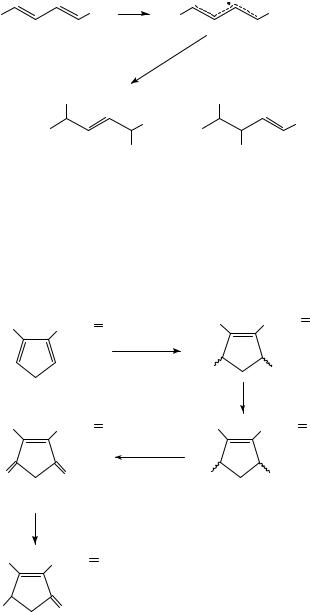
754 |
Tatsuya Shono, Shigenori Kashimura and Naoki Kise |
The typical pattern of anodic oxidation of conjugated dienes is oxidative 1,2- or 1,4- addition of nucleophiles, though the selectivity usually depends on the structure of the diene and the reaction conditions (equation 1).
R′ |
− e |
R |
|
+ |
R′ |
|
|
||||
R |
|
|
|
|
|
|
|
2Nu, − e |
|
(1) |
|
|
|
|
|
|
|
Nu |
|
|
|
Nu |
|
R |
R′ |
+ |
R |
|
R′ |
|
|
|
|||
|
|
|
|
||
|
Nu |
|
|
|
Nu |
Some typical results are shown in Table 2. The table shows that oxidation of conjugated dienes such as isoprene, piperylene (1,3-pentadiene), cyclopentadiene and 1,3-cyclohexadiene with a carbon anode in methanol or in acetic acid containing tetraethylammonium p-toluenesulfonate (Et4NOTs) as the supporting electrolyte yields mainly 1,4-addition products2. 1,3-Cyclooctadiene yields a considerable amount of the allylically substituted product.
The product, 1,4-diacetoxy-2-allyl-3-methyl-2-cyclopentene, obtained (45% current efficiency) from 2-allyl-3-methyl-1,3-cyclopentadiene through anodic oxidation with carbon rod anode in acetic acid is successfully used as a starting compound in the synthesis of allethrolone as shown in equation 23.
Me |
CH2 CH |
CH2 |
Me |
CH2 CH |
CH2 |
|
|
|
|||
|
|
− 2 e |
|
|
|
|
|
AcOH, E t3 N |
AcO |
OAc |
|
|
|
|
|
||
|
|
|
|
LiA lH4 |
|
Me |
CH2 CH |
CH2 |
Me |
CH2 CH |
CH2 |
|
|
J ones reagent |
|
|
|
O |
O |
|
HO |
OH |
(2) |
66% |
|
|
|
83% |
|
A cOH, CH2Cl2 Zn |
|
|
|
|
|
Me |
CH2 CH CH2 |
|
|
|
|
HO |
O |
|
|
|
|
91%
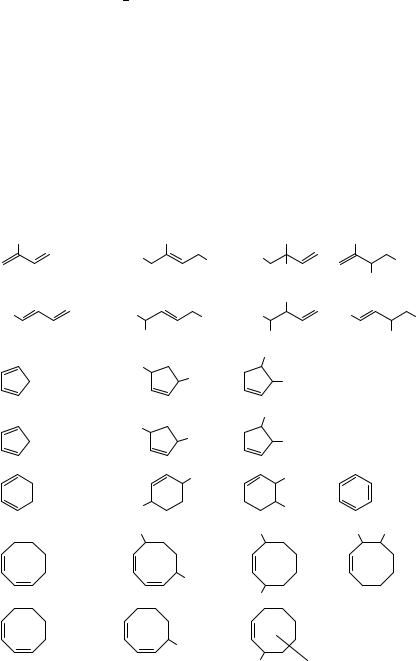
17. The electrochemistry of dienes and polyenes |
755 |
When a palladium(II) hydroquinone system is used as the mediator4 in the anodic oxidation of 1,3-cyclohexadiene in acetic acid, either trans- or cis-1,4-diacetoxy- 2-cyclohexene is formed with rather high selectivity, though the possible formation of 1,2-diacetoxylated compound is not discussed.
|
|
TABLE 1. Peak oxidation potentials Ep a of dienesb |
|
|
|
|||||
|
|
Diene |
|
Ep |
|
Diene |
|
Ep |
|
|
|
|
Butadiene |
|
2.0 |
1,3-Cyclooctadiene |
1.55; 1.70 |
|
|||
|
|
Isoprene |
|
1.75 |
1,3-Pentadiene |
|
1.48 |
|
|
|
|
|
Cyclopentadiene |
1.50 |
1,3-Cyclohexadiene |
1.36 |
|
|
|||
|
|
|
|
|
|
|
|
|
|
|
|
|
a V vs Ag/AgC . |
|
|
|
|
|
|
|
|
|
|
b Glassy carbon; solvent, methanol; supporting electrolyte, 0.5 M NaClO4 |
|
|
||||||
TABLE 2. Oxidation of conjugated dienes |
|
|
|
|
|
|
||||
|
|
|
|
|
|
|
|
|
||
1, 3-Diene |
Solvent |
|
|
Product (current efficiency %) |
|
|
|
|||
|
|
|
|
|
|
|
|
|
|
|
|
Me |
|
|
Me |
|
|
Me |
Me |
|
|
|
|
MeOH |
MeO |
OMe |
MeO |
|
|
|
OMe |
|
|
|
|
|
|
OMe |
|
|
|||
|
|
|
|
(18.6) |
|
|
|
OMe (4.0) |
||
|
|
|
|
|
|
(12.5) |
|
|||
|
|
|
|
|
|
|
OMe |
|
|
|
Me |
MeOH |
Me |
OMe |
MeO |
|
Me |
|
OMe |
||
|
|
|
|
|
|
|
|
|||
|
|
|
MeO |
(42.5) |
|
Me |
(14.7) |
|
|
OMe (11.0) |
|
|
|
|
|
|
OMe |
|
|
|
|
|
|
|
MeO |
OMe |
|
• |
|
|
|
|
|
|
MeOH |
|
|
|
OMe |
|
|
|
|
|
|
|
|
(50.6)a |
|
(6.1) |
|
|
|
|
|
|
|
|
|
|
OAc |
|
|
|
|
|
|
|
AcO |
OAc |
|
• |
|
|
|
|
|
|
AcOH |
|
|
|
OAc |
|
|
|
|
|
|
|
|
|
|
|
|
|
||
|
|
|
|
(45.0)a |
|
(6.0) |
|
|
|
|
|
|
MeOH |
|
OMe |
|
• |
OMe |
|
|
|
|
|
|
(47.2)a |
|
|
(11.8) |
|
(2.8) |
||
|
|
|
|
|
|
|
||||
|
|
|
MeO |
|
|
|
OMe |
|
|
|
|
|
|
MeO |
|
|
MeO |
|
MeO |
|
OMe |
|
|
|
|
|
|
|
|
|
|
• |
|
|
MeOH |
|
(23.5) |
|
(41.0)a |
|
(8.2) |
||
|
|
|
|
OMe |
|
|
|
|
|
|
|
|
|
|
|
|
MeO |
|
|
|
|
|
|
AcOH |
|
(53.6) |
|
|
(16.6) |
|
|
|
|
|
|
|
|
|
|
|
|
||
|
|
|
|
OAc |
|
|
|
|
|
|
|
|
|
|
|
|
|
|
|
|
|
|
|
|
|
|
|
AcO |
OAc |
|
|
|
|
|
|
|
|
|
|
|
|
||
a Mixture (1:1) of cis and trans isomers |
|
|
|
|
|
|
|
|||
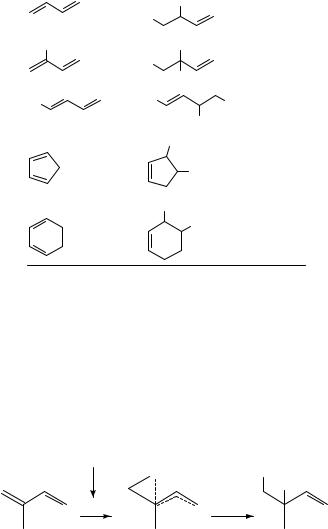
756 |
|
Tatsuya Shono, Shigenori Kashimura and Naoki Kise |
|||
|
TABLE 3. Bromomethoxylation of 1,3-dienes |
|
|||
|
|
|
|
|
|
|
|
1, 3-Diene |
|
Products |
Yield (%) |
|
|
|
|
|
|
|
|
|
|
OMe |
|
|
|
|
Br |
|
40 |
|
|
Me |
|
Me |
|
|
|
|
Br |
|
64 |
|
|
|
|
OMe |
|
|
|
|
|
|
|
|
Me |
Me |
Br |
|
|
|
|
66 |
|||
|
|
|
|
OMe |
|
|
|
|
|
|
|
OMe
• |
|
Br |
41 |
|
OMe
• Br
45
In this reaction, the redox couple hydroquinone/benzoquinone promotes the second
redox couple Pd(0) Pd(II) and Pd(II) causes the oxidative transformation of the
diene to the 1,4-diacetoxylated compound. The most remarkable characteristic of this reaction
is that the oxidation takes place at anode potential lower than 1 V vs SCE. In a typical case, the yield of 1,4-diacetoxy-2-cyclohexene is 61% with a trans:cis ratio of 86:14. On the other hand, the ratio is 10:90 (34% yield) when the reaction is carried out in the presence of chloride anion5.
1,2-Addition takes place selectively when the reaction is carried out in methanol by using the redox couple of Br /BrC as the mediator as shown by some typical examples in Table 36. The mechanism of this 1,2-addition may be as shown in equation 3 on the basis that it is regioand stereoselective and follows the Markovnikov rule.
Br− |
|
|
−2e |
Br+ |
Br |
|
|
OMe |
Br+ |
|
(3) |
|
MeOH |
The electrophilic bromonium ion adds to the diene at the position which yields the most stable cationic intermediate and the stereochemical relation of the Br and the MeO group in the product is always trans when the diene system is cyclic. The fact that 1,2-addition takes place selectively but 1,4-addition does not occur is explained by the formation of the bridged bromonium ion as the intermediate.
When conjugated dienes are anodically oxidized with a graphite anode in MeCN in the presence of NaClO4 and N,N0 -dimethylurea, a variety of 2-imidazolidinones are formed though the yields are not always high as exemplified in equation 47.
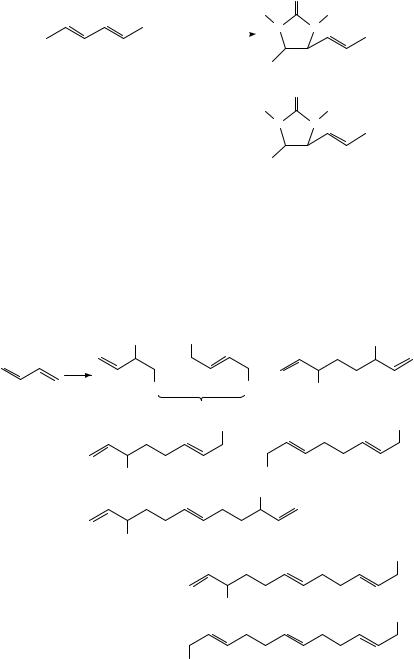
17. The electrochemistry of dienes and polyenes |
757 |
|||||
|
|
|
|
|
O |
|
+ |
(MeNH)2 CO |
−2e |
|
N |
N |
|
|
|
• |
|
|
||
|
|
|
|
|
|
|
|
|
|
|
|
20% |
(4) |
|
|
|
|
|
O |
|
|
|
|
+ |
N |
N |
|
|
|
|
• |
• |
|
|
|
|
|
|
|
||
|
|
|
|
|
20% |
|
The products of electrochemical oxidation of conjugated dienes are considerably affected by the reaction conditions such as the material of the electrode, the
supporting electrolyte and |
the solvent. The oxidation of butadiene |
with a graphite |
or carbon-cloth anode in |
0.5 M methanolic solution of NaClO4 |
mainly yields |
dimerized products along with small amounts of monomeric and trimeric compounds (equation 5)1. The use of platinum or glassy carbon mainly gives monomeric products. Other dienes such as isoprene, 1,3-cyclohexadiene, 2,4-hexadiene, 1,3-pentadiene and 2,3-dimethyl-1,3-butadiene yield complex mixtures of isomers of monomeric, dimeric and trimeric compounds, in which the dimeric products are the main products.
|
OMe |
OMe |
|
OMe |
− e |
+ |
|
+ |
|
|
|
|
||
MeOH |
OMe |
|
OMe |
OMe |
|
|
0−4% |
|
14% |
|
|
OMe |
|
OMe |
+ |
|
|
+ |
|
|
OMe |
|
OMe |
|
|
14% |
|
OMe |
14% |
|
|
|
|
|
|
OMe |
|
|
|
|
|
4% |
|
OMe |
|
|
|
|
|
|
+ |
|
|
|
|
|
OMe |
4% |
|
|
|
|
OMe |
|
|
|
|
|
|
|
+ |
OMe |
|
(5) |
|
|
|
|
|
|
|
|
4% |
|
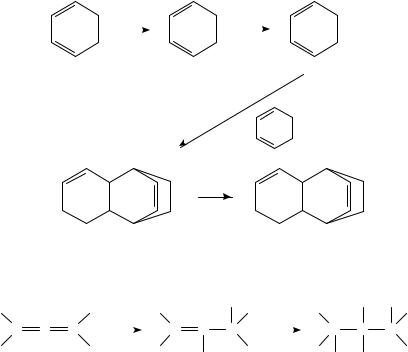
758 |
Tatsuya Shono, Shigenori Kashimura and Naoki Kise |
As mentioned above, the electrochemical oxidation of a diene yields 1,2- and 1,4- addition products when the reaction is carried out in the presence of a nucleophile such as methanol or acetic acid. When the oxidation is carried out in the absence of the nucleophile it usually yields a polymeric compound as the major product. The formation of a small amount of the Diels-Alder adduct is, however, observed when the reaction is carried out in CH2Cl2 with graphite anode. One of the proposed reaction pathways is shown in equation 68, though it is not clear whether the cyclohexadienyl radical serves as a diene (as shown in equation 6) or a dienophile in the Diels-Alder reaction.
− e |
+ • |
− H + |
|
|
•
(6)
•
The anodic oxidation of 1,2-dienes in methanol takes place stepwise at each double bond yielding a tetramethoxylated compound as one of the products (equation 7)9. This result is reasonable since a 1,2-diene is not a conjugated diene.
|
|
OMe |
|
OMe OMe |
|
C C C |
−2e |
C C C |
−2e |
C C C |
(7) |
|
|
||||
|
|
OMe |
|
OMe OMe |
|
The electrochemical oxidation of monoolefins bearing electron-donating substituents such as alkoxy, acyloxy or dialkylamino group takes place more easily than that of simple monoolefins, and products formed by the addition of a nucleophile to the double bond are obtained with satisfactory yields4.
In the case of the anodic acetoxylation of a 1-acetoxy-1,3-diene, however, the addition of the acetoxyl group to the diene is usually not regioselective, and a mixture of the two positional isomers is yielded (equation 8). On the other hand, the anodic methoxylation of the same diene gives a 4-methoxy-enone with high regioselectivity when the reaction is carried out in methanol containing 10% acetic acid (equation 9)10. Some typical results are summarized in Table 4. This anodic and regioselective methoxylation is an effective key reaction for the transposition of a carbonyl group from the original position to the-position (1,4-transposition) as shown schematically in equation 10.
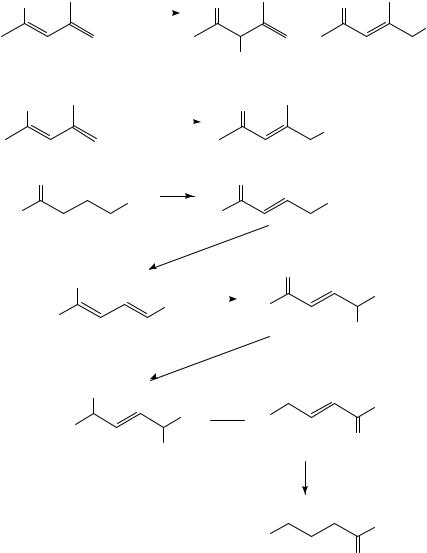
17. The electrochemistry of dienes and polyenes
OAc |
|
|
− e |
|
|
O |
O |
|
|
|
|
|
|
|
+ |
||
|
|
A cOH/A cOK |
|
|
|
|||
|
|
|
|
|
|
|||
|
|
|
|
|
|
OAc |
|
|
|
|
|
|
|
18% |
47% |
||
OAc |
|
|
− e |
|
|
O |
|
|
|
|
|
|
|
|
|
||
|
|
|
A cO H − M e O H |
|
|
|
OMe |
|
|
|
|
Et4 NO Ts |
|
|
|
|
|
|
|
|
|
|
|
|
|
81% |
O |
|
|
|
|
|
O |
|
|
R |
|
|
R′ |
|
R |
R′ |
||
|
|
|
|
|
|
|||
|
OAc |
|
|
|
O |
|||
|
|
+ e |
|
R′ |
||||
|
|
|
R′ |
|
||||
|
|
|
MeOH |
R |
||||
|
R |
|
||||||
|
|
|
|
OMe |
||||
|
|
|
|
|
|
|
|
|
759
OAc
(8)
(9)
(10)
OH
R′
R′  R
R
R
O
OMe
R′
R
O
B. Nonconjugated Dienes
Compared with conjugated dienes, the electrochemistry of nonconjugated dienes is classified into two types, A and B11,12. In type A, the double bond of the diene behaves essentially the same as the double bond of a monoolefin in the anodic oxidation. A typical
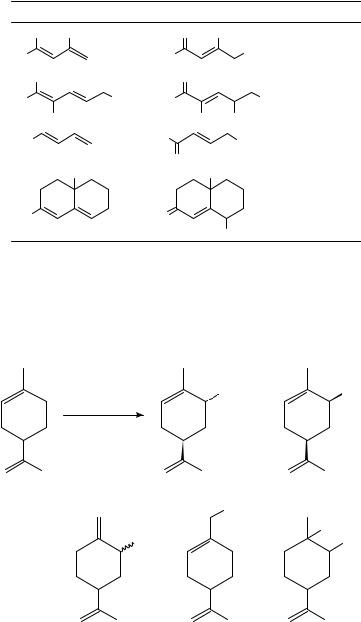
760 |
Tatsuya Shono, Shigenori Kashimura and Naoki Kise |
||||
|
TABLE 4. Anodic oxidation of enol acetates |
|
|
||
|
Dienolacetate |
|
γ-Methoxy Carbonyl Product |
Yield (%)a, b |
|
|
OAc Me |
|
O |
Me |
|
|
Me |
|
Me |
OMe |
81 |
|
|
|
|
||
|
OAc |
|
O |
|
|
|
Me |
Me |
Me |
Me |
74 |
|
Me |
|
Me |
OMe |
|
|
AcO |
|
H |
OMe |
76 |
|
|
|
|||
|
|
|
|
|
|
|
|
|
O |
|
|
|
Me |
|
Me |
|
|
|
|
|
|
|
66 |
|
AcO |
|
O |
|
|
OMe
a Isolated yields.
b The yields were obtained at the stage when 2 F/mol of electricity was passed.
example is the oxidation of limonene in methanol (equation 11) in which the reaction which actually takes place is the oxidation of the double bond located in the cyclohexene ring, followed by allylic substitution and ring contraction, whereas the isopropenyl group is retained intact. These patterns of reaction are similar to those observed in the anodic oxidation of monoolefins.
OMe |
OMe |
−2e
+
MeOH, Et4 NOTs
|
20.5% |
6.5% |
|
OMe |
(11) |
|
|
OMe |
|
OMe |
OMe |
+ |
+ |
+ |
15.7% |
2.5% |
8.9% |
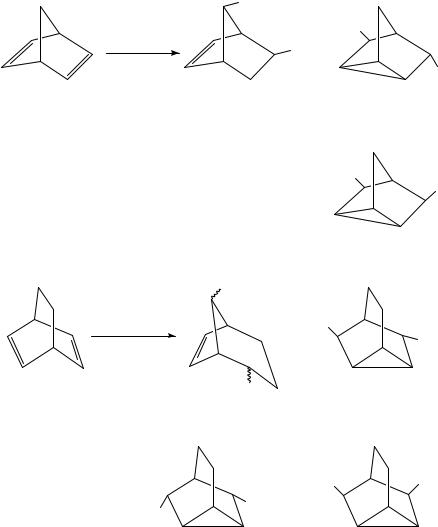
17. The electrochemistry of dienes and polyenes |
761 |
On the other hand, the electrooxidation of norbornadiene or bicyclo[2.2.2]octa-2,5-diene shows a different electrochemistry (type B) and yields a mixture of some unique products as shown in equations 12 and 13.
−2e
YH, Et4 NOTs
Y = OAc
Y = OMe
−2e
MeOH, Et4 NOTs
+
MeO
Y
6.2%
8.8%
OMe
OMe
23.8%
OMe
Y
Y +
Y
14.1%
16.5%
(12)
|
Y |
+ |
Y |
|
15.4%
18.4%
+ |
MeO |
|
OMe |
||
|
22.5% (13)
MeO |
OMe |
+
9.1% |
5.3% |
These results clearly show that in type B reactions the electrooxidation pattern is remarkably different from that of the corresponding monoolefin. The types A and B are summarized schematically in equation 14.

762 |
Tatsuya Shono, Shigenori Kashimura and Naoki Kise |
|
|
||||||
|
|
Cn |
|
|
|
Cn |
Y |
Cn |
Y |
|
|
+ |
|
− e, +YH |
+ |
|
|
||
|
|
|
|
|
|
|
|
Y |
|
|
|
|
|
|
|
|
|
|
|
Cn |
− e |
|
|
|
|
|
|
|
(14) |
|
type A |
|
|
|
|
|
|
|
|
|
− e |
Cn |
|
|
|
Cn |
|
|
|
|
|
|
|
|
|
|
|
|
|
|
type B |
|
− e, +YH |
|
|
|
|||
|
|
+ |
|
|
Y |
Y |
|
|
|
In type A reactions one electron is removed from one of the two double bonds to form a cation radical, and allylic substitution and oxidative addition take place as the following reactions. On the other hand, in type B reactions the initial electron transfer from the double bond is accompanied by a transannular reaction between the two double bonds.
The difference between dienes reacting according to type A and those according to type B is clearly reflected in their oxidation potentials (Table 5).
Thus, the oxidation potential of the former type of diene (limonene) is substantially the same as that of the corresponding monoolefin (1-Me-cyclohexene), whereas norbornadiene and bicyclo[2.2.2]octadiene show much lower oxidation potentials than those of norbornene and cyclohexene.
This result suggests that in the anodic oxidation of type B, the cation radical formed from one of the two double bonds is stabilized through transannular interaction with another double bond.
As shown in Table 6 and Figure 1, the oxidation potentials of 2-substituted norbornadienes (1), 2-substituted bicyclo[2.2.2]octa-2,5-dienes (2) and 4-substituted [2.2]paracyclophanes (3) clearly indicate that the transannular interaction between two double bonds contributes already at the stage of the first electron transfer. Namely, in compounds 1 3, the electron is transferred from the unsaturated bond which is not substituted by the electron-withdrawing group, Figure 1 shows the
TABLE 5. Oxidation potentials of dienes and the corresponding monoolefins (V vs SCE)a
Norbornene |
2.02 |
Cyclohexene |
2.14 |
1-Me-Cyclohexene |
1.70 |
Norbornadiene |
1.54 |
Bicyclo[2.2.2]octadiene |
1.82 |
Limonene |
1.67 |
a Solvent: MeCN; supporting electrolyte, 0.1 M LiClO4.
TABLE 6. Oxidation potentials of 1, 2 and 3
Substituent X Oxidation potential (V vs. SCE)
|
1 |
2 |
3 |
|
|
|
|
H |
1.54 |
1.82 |
1.47 |
CO2Me |
|
|
1.61 |
CO2Et |
1.85 |
2.11 |
|
COMe |
1.85 |
2.07 |
1.57 |
CN |
1.99 |
2.22 |
1.65 |
NO2 |
|
|
1.72 |
